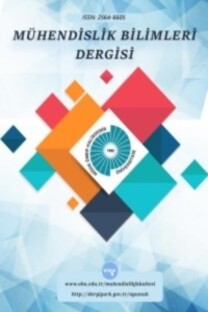Elektroeğirilmiş polivinilpirolidon / grafit kompozit nanofiber keçeler: katkının morfoloji ve ıslanabilirlik üzerine etkisi
elektroeğirme, polivinilpirolidon, grafit, nanolifler, ıslanabilirlik
Electrospun polyvinylpyrrolidone / graphite composite nanofiber mats: effect of the filler on the morphology and wettability
electrospinning, polyvinylpyrrolidone, graphite, nanofibers, wettability,
___
- Kenry and C. T. Lim, Nanofiber technology: current status and emerging developments, Progress in Polymer Science, 70, 1-17, 2017. https://doi.org/ 10.1016/j.progpolymsci.2017.03.002
- Z.-M. Huang, Y.-Z. Zhang, M. Kotaki and S. Ramakrishna, A review on polymer nanofibers by electrospinning and their applications in nanocomposites, Composites Science and Technology, 63, 2223-2253, 2003. https://doi.org/ 10.1016/S0266-3538(03)00178-7
- M. Teodorescu and M. Bercea, Poly(vinylpyrrolidone) – A versatile polymer for biomedical and beyond medical applications, Polymer Plastics Technology and Engineering, 54, 923-943, 2015. https://doi.org/ 10.1080/03602559.2014.979506
- A. Nag, N. Afasrimanesh, S. Feng and S. C. Mukhopadhyay, Strain induced graphite/PDMS sensors for biomedical applications, Sensors and Actuators A: Physical, 271, 257-269, 2018. https://doi.org/10.1016/j.sna.2018.01.044
- Y. L. Hsin, K. C. Hwang and C.-T. Yeh, Poly(vinylpyrrolidone)-Modified graphite carbon nanofibers as promising supports for ptru catalysts in direct methanol fuel cells, JOrnal of American Chemical Society, 129, 9999-10010, 2007. https://doi.org/10.1021/ja072367a
- R. S. Kurusu and N. R. Demarquette, Surface modification to control the water wettability of electrospun mats, International Materials Reviews, 64(5), 249-287, 2019. 10.1080/09506608.2018. 1484577
- M. Maleki, A. Natalello, R. Pugliese and F. Gelain, Fabrication of nanofibrous electrospun scaffolds from a heterogenous library of co- and self-assembling peptides, Acta Biomaterialia, 51, 268-278, 2017. https://doi.org/10.1016/j.actbio.2017.01.038
- S. Huang, L. Zhou, M.-C. Li, Q. Wu, Y. Kojima and D. Zhou, Preparation and properties of electrospun poly(vinyl pyrrolidone)/cellulose nanocrystal/silver nanoparticle composite fibers, Materials, 9, 523, 2016. https://doi.org/10.3390/ma9070523
- M. A.-F. Basha, Magnetic and optical studies on polyvinylpyrrolidone thin films doped with rare earth metal salts, Polymer Journal, 42, 728-734, 2010. https://doi.org/10.1038/pj.2010.60
- E. Adeli, Irbesartan-loaded electrospun nanofibers-based PVP K90 for the drug dissolution improvement: Fabrication, in vitro performance assessment, and in vivo evaluation, Journal of Applied Polymer Science, 42212, 2015. https://doi.org/ 10.1002/app.42212
- G. Nie, X. Tong, Y. Zhang and S. Xue, Efficient production of 5-hydroxymethylfurfural (HMF) from D-fructose and inulin with graphite derivatives as catalysts, Catalysis Letters, 144, 1759-1765, 2014. https://doi.org/10.1007/s10562-014-1320-7
- J. S. LaFontaine, L. K. Prasad, C. Brough, D. A. Miller, J. W. McGinity and R. O. Williams III, Thermal processsing of PVP- and HPMC- based amorphous solid dispersions, AAPS Pharm SciTech, 17(1), 120-132, 2016. https://doi.org/ 10.1208/s12249-015-0417-7
- A. Kozbial, F. Zhou , Z. Li, H. Liu and L. Li , Are graphitic surfaces hydrophobic?, Accounts of Chemical Research, vol. 49, no. 12, pp. 2765-2773, 2016. https://doi.org/10.1021/acs.accounts.6b00447
- ISSN: 2564-6605
- Yayın Aralığı: 4
- Başlangıç: 2017
- Yayıncı: Niğde Ömer Halisdemir Üniversitesi
Bacillus sp. ile iyileştirilmiş zeminlerin donma çözülme etkisindeki davranışı
Baki BAĞRIAÇIK, Fatıma Masume USLU, Esra Sunduz YİĞİTTEKİN, Anıl DELİK, Sadık DİNÇER
Covid-19 ile mücadelede bitkilerin olası rolü
Meltem BAYRAKTAR, Begüm GÜLER, Aynur GÜREL
Analitik hiyerarşi prosesi (AHP) yöntemi ile çalışan performansının değerlendirilmesi
Emine Elif NEBATİ, Gülser Narin SAĞANDA, Hayriye EROL, Sümeyye Reyyan SUBAŞI, Tuğçe Esma GÖZ
